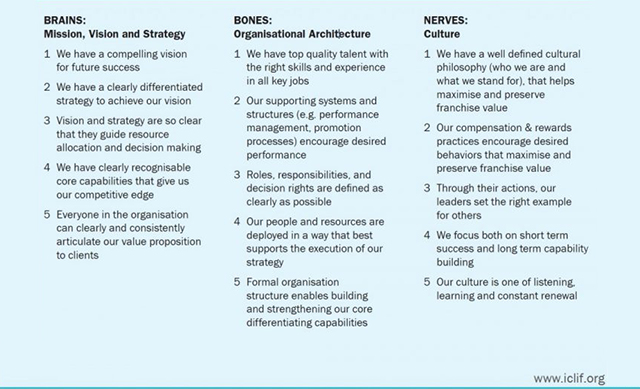The other duty of corporate governance

Leadership & Management
298 week ago — 9 min read
Background: CEO of The Iclif Leadership and Governance Centre, Rajeev Peshawaria opines that 'enterprise value enhancement' is an integral responsibility of corporate governance and yet very often this is under served. In his previous article titled 'Career Value Curves' Mr Peshawaria talked about how in present times acquiring skills is not enough, out of the box thinking is required to succeed. In this article he shares a simple but powerful information system that can help boards better fulfill their duty of 'enterprise value enhancement'.
Most definitions place significant emphasis on enterprise value preservation, which largely comprises of rules, regulatory compliance, risk management, and other types of watchdog activities. Clearly, value preservation is an important duty of the Board of Directors. In the aftermath of the 2008 global financial crisis and the recession that followed, defending against downsides has become more important than ever before. However, there is another equally important side to the board’s responsibilities – enterprise value enhancement – that I believe might be slightly under served by boards today.
Consider the following. By some estimates, 65% of a company’s stock price is attributable to intangible value, promises of future economic benefits based on the quality of leadership and management, the company’s ability to innovate, the depth of talent, employee engagement, etc. While most boards recognise this duty to ensure that management does all it can to maximise this future value as well as stave off present dangers, in this article, I want to offer a simple but powerful information system that can help boards better fulfill this duty.
Enterprise value preservation, largely comprises of rules, regulatory compliance, and other types of watchdog activities. However, there is another equally important side to the board’s responsibilities – enterprise value enhancement.
Before I do so, consider a question my colleagues and I have been asking senior management teams over the past 12 years:
On a 1 – 10 scale where 1 is “well below our potential” and 10 is “at peak potential,” how is your organisation currently performing in the marketplace?

The average answer we get each time we ask is around 6.5. This means, by their own admission, captains of industry are saying they can be 35% more successful without adding any more resources. Can you imagine if your organisation were 35% more successful? What can management do to go after that elusive 35%?
And what can boards do to find out if management is indeed doing it? To answer these questions, lets first take a quick look at what companies do to destroy value. In his book, “The Self Destructing Habits of Good Companies, And How to Break Them,” Jagdish N Sheth lists the following seven habits that eventually make good companies go bad:
- DENIAL: Refusal to recognise or acknowledge reality
- ARROGANCE: Overblown self image that just doesn’t square up with the facts
- COMPLACENCY: Sense of security from the belief that past successes will continue indefinitely
- COMPETENCY DEPENDENCE: Limited vision due to over dependence on one core competency
- COMPETITIVE MYOPIA: Defining your competition too narrowly
- VOLUME OBSESSION: Rising costs and falling margins
- TERRITORIAL IMPULSE: Culture conflicts and turf wars within a company’s silos
Again, how can the board safeguard against the possibility of one or more of the above habits taking root in the company? More importantly, how can board members coach senior management when they see the symptoms? A good place to start might be to better understand what is really going on in the company. If a company is not achieving its full potential, the first people to find out are usually the employees. A simple way to find out, therefore, is to ask them.
Also read: 5 critical questions for leadership success and life happiness
A few years ago, I devised a simple framework that links current company performance to future value The premise: a company must proactively shape and maintain three pillars of sustainable growth that I call B-B-N: Brains (vision and strategy), Bones (organisational architecture) and Nerves (culture) of the business. I have described this framework in a fair amount of detail in Too Many Bosses, Too Few Leaders (Free Press 2011) and in other articles and blog posts.
However, in each of the earlier texts, I looked at B-B-N from the perspective of the management. I described it as a framework through which management can stay in touch with reality and take corrective action proactively. My purpose in this piece is to present B-B-N as a source of information for the board of directors, and explain how board members can use the information to help management in maximising the future intangible value of the enterprise.
The process begins with a very quick survey Employees are asked to rate each of the following statements on a 1-5 scale.

The desired response score for each of the survey statements should be 4 or 5. In other words, if management is doing a good enough job of enhancing future value, employees must either agree or strongly agree to each of the above statements. Any response score below 4 means there is work to be done. For example, if management feels it has done a huge amount of work in formulating and communicating a compelling vision and strategy, employees should agree or strongly agree to the five statements under the Brains section. If the average response is 3 or below, it means either that the strategy is not compelling, or that management needs to do a better job of communicating and cascading it. In either case, it (management) has work to do. The B-B-N survey is an instant pulse check to find out if management actions are perceived (by employees) to be hitting the bull’s eye or not.
The results of this survey can easily be plotted on a one-page graph to provide quick visual stimulation. To make the data richer, companies may add another question in the end asking for verbatim comments to substantiate ratings to the 15 statements. I have successfully used this tool with many management teams across the world to help them generate ideas for growth acceleration. However, like any other information tool, the data needs to be used with good judgment after taking the broader business landscape into account. The employee perspective is just one perspective, but an important one for boards and management to consider.
Also read: The truth about trust
If boards insist on seeing the results of this survey on a periodic basis, they can engage in a very healthy dialogue with management about what can be done to address issues if any. Some board members (with their own vast corporate experience) can even coach senior management once they understand the crux of the issues. I know one CEO who regularly sits down with his chairman to discuss the company’s B-B-N scores and seeks her feedback and coaching. When I asked him why he does so and were their any risks involved in opening up the whole kimono with the Chairman, he said, “… on the contrary, I see only upside in sharing the information with the Chairman and seeking her guidance. There’s a double bottom line here …. 1) by sharing honestly, I involve her in addressing the problem(s). Rather than a jury, the board now becomes a partner. And 2) I almost always get good coaching … there are very few places a CEO can go to for good coaching, but your board is one of them…. and we tend to under use this source …”
Most companies administer lengthy employee satisfaction surveys. But, as one of my colleagues points out, satisfaction surveys only measure if people are happy with the pay and rations. The B-B-N survey takes only seven minutes to fill out, but gives real and tangible information about the impact of the actions of the senior management team in driving long term sustainable growth as perceived by employees. For board members, it can be a powerful tool in fulfilling their duties without micro-managing the CEO.
Also read: Why we need younger boards in the 21st century
Image courtesy: Shutterstock.com
Article source: https://iclif.org/articles/the-other-duty-of-corporategovernance/
To explore business opportunities, link with me by clicking on the 'Connect' button on my eBiz Card.
Disclaimer: The views and opinions expressed in this article are those of the author and do not necessarily reflect the views, official policy or position of GlobalLinker.
View Rajeev 's profile
Other articles written by Rajeev Peshawaria
Let the cream naturally rise to the top
293 week ago
Most read this week












Comments
Share this content
Please login or Register to join the discussion